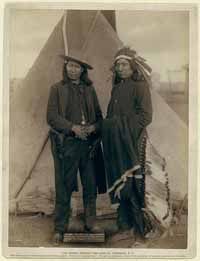The Sioux (pronounced /ˈsuː/) are a Native American and First Nations people in North America. The term can refer to any ethnic group within the Great Sioux Nation or any of the nation's many language dialects. The Sioux comprise three major divisions based on Siouan dialect and subculture:
- Isáŋyathi or Isáŋathi ("Knife," originating from the name of a lake in present-day Minnesota): residing in the extreme east of the Dakotas, Minnesota, and northern Iowa, and are often referred to as the Santee or Eastern Dakota.
- Iháŋktȟuŋwaŋ and Iháŋktȟuŋwaŋna ("Village-at-the-end" and "little village-at-the-end"): residing in the Minnesota River area, they are considered to be the middle Sioux, and are often referred to as the Yankton and the Yanktonai, or, collectively, as the Wičhíyena (endonym) or the Western Dakota (and have been erroneously classified as “Nakota”[3]) .
- Thítȟuŋwaŋ or Teton (uncertain, perhaps "Dwellers on the Prairie"; this name is archaic among the natives, who prefer to call themselves Lakȟóta[4]): the westernmost Sioux, known for their hunting and warrior culture, are often referred to as the Lakota.
Today, the Sioux maintain many separate tribal governments scattered
across several reservations, communities, and reserves in the Dakotas, Nebraska, Minnesota, and Montana in the United States; and Manitoba and southern Saskatchewan in Canada.
Očhéthi Šakówiŋ
The historical Sioux referred to the Great Sioux Nation as the Očhéthi Šakówiŋ (pronounced [oˈtʃʰetʰi ʃaˈkowĩ]),
meaning "Seven Council Fires". Each fire was symbolic of an oyate
(people or nation). The seven nations that comprise the Sioux are:
Bdewákaŋthuŋwaŋ (Mdewakanton), Waȟpéthuŋwaŋ (Wahpeton), Waȟpékhute (Wahpekute), Sisíthuŋwaŋ (Sisseton), the Iháŋkthuŋwaŋ (Yankton), Iháŋkthuŋwaŋna (Yanktonai) Thítȟuŋwaŋ (Teton or Lakota).[5]
The Seven Council Fires would assemble each summer to hold council,
renew kinships, decide tribal matters, and participate in the Sun Dance.[6] The seven divisions would select four leaders known as Wičháša Yatápika from among the leaders of each division.[6]
Being one of the four leaders was considered the highest honor for a
leader; however, the annual gathering meant the majority of tribal
administration was cared for by the usual leaders of each division. The
last meeting of the Seven Council Fires was in 1850.[6]
Today the Teton, Santee, and Ihantowan/Ihanktowana are usually known,
respectively, as the Lakota, Eastern Dakota, or Western Dakota.[4][5]
In any of the three main dialects, "Lakota" or "Dakota" translate to
mean "friend," or more properly, "ally." Usage of Lakota or Dakota may
then refer to the alliance that once bound the Great Sioux Nation .
Name origins
The name "Sioux" is an abbreviated form of Nadouessioux borrowed into French Canadian from Nadoüessioüak from the early Odawa exonym: naadowesiwag "Sioux".[8] Jean Nicolet recorded the use in 1640.[5] The Proto-Algonquian form *na·towe·wa, meaning "Northern Iroquoian", has reflexes in several daughter languages that refer to a small rattlesnake (massasauga, Sistrurus).[9] This information was interpreted by some that the Ottawa borrowing was an insult. However, this Proto-Algonquian term most likely was ultimately derived from a form *-a·towe·, meaning simply to "speak foreign language",[8] Later this was extended in meaning in some Algonquian languages to refer to the massasauga. Thus, contrary to many accounts, the old Odawa word naadowesiwag
did not equate the Sioux with snakes. This is not confirmed though,
since usage over the previous decades has led to this term having
negative connotations to those tribes to which it refers. This would
explain why many tribes have rejected this term as an autonym.
Some of the tribes have formally or informally adopted traditional names: the Rosebud Sioux Tribe is also known as the Sičháŋǧu Oyáte, and the Oglala often use the name Oglála Lakȟóta Oyáte, rather than the English "Oglala Sioux Tribe" or OST. (The alternative English spelling of Ogallala is considered improper).[5]


